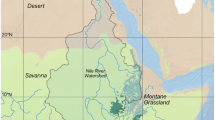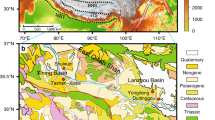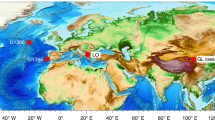Abstract
Few long proxy climatic records are available from terrestrial locations. The isotope records of Pleistocene climate change found in marine cores reflect worldwide ice-volume and temperature changes forced by variations in the Earth's orbital geometry. Comparable terrestrial records are rare. Loess (wind-deposited silt) is perhaps the closest terrestrial analogue to marine sediments in that both result from more-or-less continuous deposition of fine-grained sediment. Here we examine the hypothesis that mag-netic susceptibility variations through loess sections reflect climate forcing. We statistically tested cross-correlations between high-precision, orbitally tuned marine oxygen isotope curves recording the past 250,000 yr BP, and magnetic susceptibility profiles through a thick loess section in central Alaska. Highly significant (P> 0.0001) correlations indicate strong, thick palaeosols formed in Arctic loess during early parts of interglacial periods correspond-ing to isotope stages 7 and 5. Thinner soils formed during interstadial events corresponding to early stage 7 and stage 3. Autocorrelation and time-series analysis of the loess data show spectral peaks at 125,000, 41,000 and 23,000 yr BP, showing for the first time that terrestrial orbital periodicities influenced and are recorded in proxy climatic data from terrestrial aeolian deposits at high latitudes.
This is a preview of subscription content, access via your institution
Access options
Subscribe to this journal
Receive 51 print issues and online access
$199.00 per year
only $3.90 per issue
Buy this article
- Purchase on Springer Link
- Instant access to full article PDF
Prices may be subject to local taxes which are calculated during checkout
Similar content being viewed by others
References
Tungsheng, L., Zhisheng, A., Baoyin, Y. & Jiamao, H. Episodes 8, 21–28 (1985).
Kukla, G. Quat. Sci. Rev. 6, 191–219 (1987).
Bloemendal, J. EOS 68, 1258 (1987).
Leg 117 Scientific Drilling Party Geotimes 33, 13–16 (1988).
Péwé, T. Bull. geol. Soc. Am. 66, 699–724 (1955).
Péwé, T. U.S. Geol. Surv. Prof. Paper 835, 145 pp (1975).
Beget, J. Proc. Fifth Int. Permafrost Conf. 672–677 (1988).
Westgate, J., Walter, R., Pearce, G. & Gorton, M. Can. J. Earth Sci. 22, 893–906 (1985).
Wintle, A. & Westgate, J. Geology 14, 594–597 (1986).
Berger, G. W. Can. J. Earth Sci. 24, 1975–1984 (1987).
Juvigne, E. & Porter, S. Geogr. phys. Quat. 39, 7–12 (1985).
Thorson, R. & Bender, G. Bull. geol. Soc. Am. 96, 702–709 (1985).
Debenham, N. C. Nuclear Tracks 10, 717–724 (1985).
Wintle, A. Geologic en Mijnbouw 66, 35–42 (1987).
Westgate, J. Science 218, 789–790 (1982).
Naeser, N., Westgate, J., Hughes, O. & Pewe, T. Can. J. Earth Sci. 19, 2167–2178 (1982).
Westgate, J. Geophys. Res. Lett. 15, 376–379 (1988).
Naeser, N. & Naeser, C. in Quaternary Dating Methods (ed. Mahaney, W.) 87–100 (Elsevier, Amsterdam, 1984).
Naeser, C., Briggs, N., Obradovich, J. & Izett, G. in Tephra Studies (ed. Self, S. & Sparks, R.) 13–48 (Reidel, Dordrecht, 1981).
McKenna, T., Lerche, I., Williams, D. & Full, W. Palaeogeogr. Palaeoclimatol. Palaeocol. 64, 241–264 (1988).
Pisias, N. et al. Mar. Geol. 56, 119–136 (1984).
Martinson, D. et al. Quat. Res. 27, 1–29 (1987).
Imbrie, J. & Imbrie, J. Science 207, 943–953 (1980).
Bloom, A., Broecker, W., Chappel, J., Mathews, R. & Mesolella, K. Quat. Res. 4, 185–205 (1974).
Fairbanks, R. & Mathews, R. Quat. Res. 10, 181–196 (1978).
Dodge, R., Fairbanks, R., Benninger, L. & Maurasse, F. Science 219, 1423–1425 (1983).
Hays, J., Imbrie, J. & Shackleton, N. Science 194, 1121–1132 (1976).
Berger, A. L. Quat. Res. 9, 139–167 (1978).
Milankovitch, M. Kanon der Erdbestrahlung une sei Eiszeitenproblem (Acad. R. Serbe, Belgrad, 1941).
Emiliani, C. J. Geol. 74, 109–126 (1966).
Ruddiman, W. & Mclntyre, A. Science 204, 173–175 (1979).
Kominz, M. & Pisias, N. Science 204, 171–173 (1979).
Broecker, W. Science 151, 299–304 (1966).
Author information
Authors and Affiliations
Rights and permissions
About this article
Cite this article
Begét, J., Hawkins, D. Influence of orbital parameters on Pleistocene loess deposition in central Alaska. Nature 337, 151–153 (1989). https://doi.org/10.1038/337151a0
Received:
Accepted:
Issue Date:
DOI: https://doi.org/10.1038/337151a0
This article is cited by
-
Rock-magnetic characteristics and mechanisms of the Titel loess-paleosol sequence in northern Serbia since late Middle Pleistocene
Science China Earth Sciences (2022)
-
Identification of aeolian loess deposits on the Indo-Gangetic Plain (India) and their significance
Science China Earth Sciences (2017)
-
Magnetostratigraphy and environmental magnetism in a Pleistocene sedimentary sequence, Marcos Paz, Argentina
Environmental Earth Sciences (2013)
-
The magnetic properties of Serbian loess and its environmental significance
Chinese Science Bulletin (2013)
-
Susceptibility variations of multiple origins of loess from the Ily Basin (NW China)
Chinese Science Bulletin (2012)
Comments
By submitting a comment you agree to abide by our Terms and Community Guidelines. If you find something abusive or that does not comply with our terms or guidelines please flag it as inappropriate.



